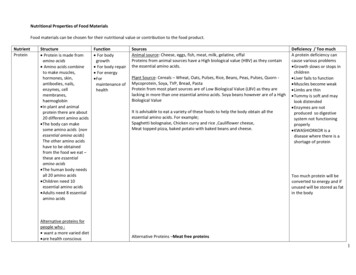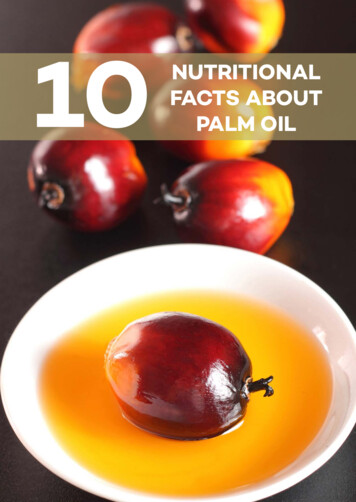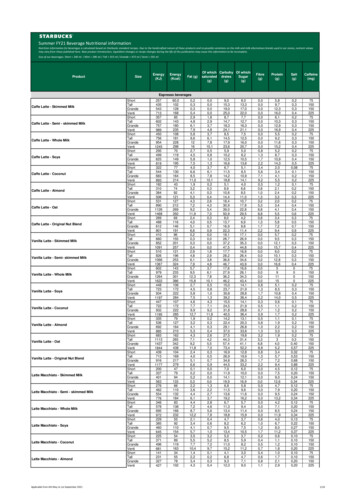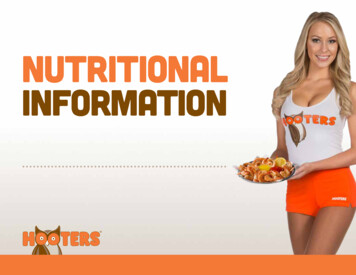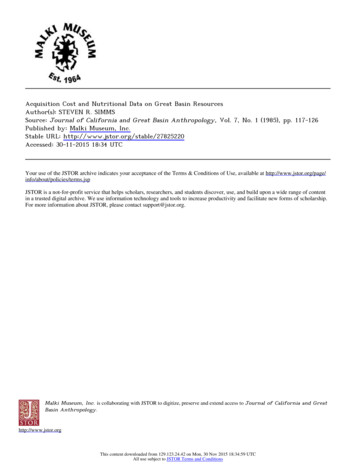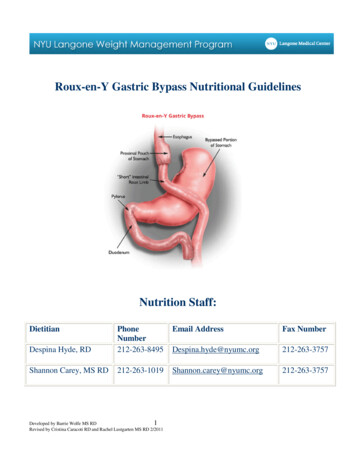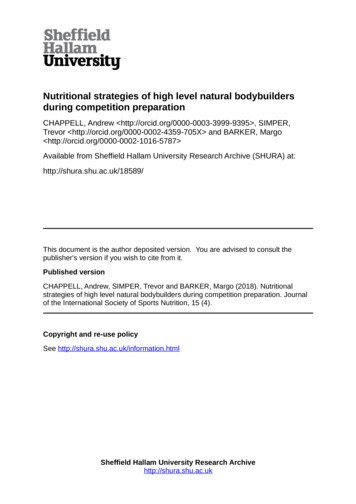
Transcription
Nutritional strategies of high level natural bodybuildersduring competition preparationCHAPPELL, Andrew http://orcid.org/0000-0003-3999-9395 , SIMPER,Trevor http://orcid.org/0000-0002-4359-705X and BARKER, Margo http://orcid.org/0000-0002-1016-5787 Available from Sheffield Hallam University Research Archive (SHURA) at:http://shura.shu.ac.uk/18589/This document is the author deposited version. You are advised to consult thepublisher's version if you wish to cite from it.Published versionCHAPPELL, Andrew, SIMPER, Trevor and BARKER, Margo (2018). Nutritionalstrategies of high level natural bodybuilders during competition preparation. Journalof the International Society of Sports Nutrition, 15 (4).Copyright and re-use policySee http://shura.shu.ac.uk/information.htmlSheffield Hallam University Research Archivehttp://shura.shu.ac.uk
Chappell et al. Journal of the International Society of Sports Nutrition(2018) 15:4DOI 10.1186/s12970-018-0209-zRESEARCH ARTICLEOpen AccessNutritional strategies of high level naturalbodybuilders during competitionpreparationA. J. Chappell* , T. Simper and M. E. BarkerAbstractBackground: Competitive bodybuilders employ a combination of resistance training, cardiovascular exercise,calorie reduction, supplementation regimes and peaking strategies in order to lose fat mass and maintain fat freemass. Although recommendations exist for contest preparation, applied research is limited and data on the contestpreparation regimes of bodybuilders are restricted to case studies or small cohorts. Moreover, the influence ofdifferent nutritional strategies on competitive outcome is unknown.Methods: Fifty-one competitors (35 male and 16 female) volunteered to take part in this project. The British NaturalBodybuilding Federation (BNBF) runs an annual national competition for high level bodybuilders; competitors mustqualify by winning at a qualifying events or may be invited at the judge’s discretion. Competitors are subject tostringent drug testing and have to undergo a polygraph test. Study of this cohort provides an opportunity toexamine the dietary practices of high level natural bodybuilders. We report the results of a cross-sectional study ofbodybuilders competing at the BNBF finals. Volunteers completed a 34-item questionnaire assessing diet at threetime points. At each time point participants recorded food intake over a 24-h period in grams and/or portions.Competitors were categorised according to contest placing. A “placed” competitor finished in the top 5, and a“Non-placed” (DNP) competitor finished outside the top 5. Nutrient analysis was performed using Nutritics software.Repeated measures ANOVA and effect sizes (Cohen’s d) were used to test if nutrient intake changed over time andif placing was associated with intake.Results: Mean preparation time for a competitor was 22 9 weeks. Nutrient intake of bodybuilders reflected ahigh-protein, high-carbohydrate, low-fat diet. Total carbohydrate, protein and fat intakes decreased over time inboth male and female cohorts (P 0.05). Placed male competitors had a greater carbohydrate intake at the start ofcontest preparation (5.1 vs 3.7 g/kg BW) than DNP competitors (d 1.02, 95% CI [0.22, 1.80]).Conclusions: Greater carbohydrate intake in the placed competitors could theoretically have contributed towardsgreater maintenance of muscle mass during competition preparation compared to DNP competitors. These findingsrequire corroboration, but will likely be of interest to bodybuilders and coaches.Keywords: Bodybuilders, Calories, Competition, Contest preparation, Dieting, Energy restriction, Natural, Nutrition,Supplementation, Physique* Correspondence: a.chappell@shu.ac.ukFood and Nutrition Group, Sheffield Business School, Sheffield HallamUniversity, Howard Street, Sheffield S1 1WB, UK The Author(s). 2018 Open Access This article is distributed under the terms of the Creative Commons Attribution 4.0International License (http://creativecommons.org/licenses/by/4.0/), which permits unrestricted use, distribution, andreproduction in any medium, provided you give appropriate credit to the original author(s) and the source, provide a link tothe Creative Commons license, and indicate if changes were made. The Creative Commons Public Domain Dedication o/1.0/) applies to the data made available in this article, unless otherwise stated.
Chappell et al. Journal of the International Society of Sports Nutrition (2018) 15:4BackgroundIn competitive bodybuilding, athletes are judged on theirmuscularity (muscle size), conditioning (the absence ofbody fat) and symmetry (muscular proportion). In orderto achieve the required physique, athletes undertake fatloss regimes, whilst attempting to maintain lean bodymass (LBM) accrued prior to the fat loss period [1, 2].Athletes and their coaches use a combination of resistance training, cardiovascular exercise, calorie restriction,supplementation and peaking strategies in order toobtain a competition-ready physique [3]. Bodybuilderspreparing for competition usually follow self- or coachprescribed diets, which often are comprised of a limitedand repetitive food regime, with the sole aim of supplying specific amounts of protein, fat and carbohydrate[3–8]. Following these stringent dietary approaches iscommon practice and connects with the notion of being“hardcore” celebrated amongst bodybuilders [9]. Although broad recommendations exist for both nutrientintakes and exercise prescription [10–12], these recommendations are theoretical, imprecise, and open to interpretation. There is also a paucity of applied research onhigh level bodybuilders.Recently a meta-analytic study combined 18 separatestudies on the dietary intake of bodybuilders [13]. Thisstudy reported that male competitors consumed on average 3292 kcal per day during contest preparation, with52% of that energy coming from carbohydrate, 28% fromprotein, and 22% from fat. Female competitors by way ofcomparison consumed 1739 kcal per day with 59% energy from carbohydrate, 28% energy from protein and12% energy from fat. Although the meta-analysis incorporated 385 participants, the majority of the studieswere published in the 1980s and 1990s and were nonspecific about participants’ phase of training, which maybe ‘off-season’ (prior to beginning contest preparation),during contest preparation (often a period of 8–24 weeksbefore competition), or 1 week from competition (theimmediate pre-contest or peaking phase). The frequentuse of androgenic anabolic steroids (AAS) amongst competitive bodybuilders also confounds identification of optimal nutritional strategies and training regimes. Indeedone third of the studies included in the meta-analysisreported AAS use by athletes [13]. Furthermore, thepractices employed by athletes in the new physique categories, such as men’s physique, figure/ athletic, sports/fitness and swimsuit/bikini, which emphasize beauty rather than muscularity have not been scrutinised. Moreover, the lack of scrutiny of the practices employedwithin the aforementioned divisions may mislead bodybuilders as to what are the most effective strategies forcompetitive bodybuilding.Within the United Kingdom (UK), the British NaturalBodybuilding Federation (BNBF) runs nine regionalPage 2 of 12qualifying competitions; the regional qualifiers culminatein a UK final championship, where the overall winner isawarded professional status. This cohort provides an excellent opportunity to study the nutritional practices of ahigh level group of natural bodybuilders. The strategiesemployed by the most successful natural bodybuilderscan be compared to recommendations [11], which include protein intake of between 2.3 and 3.1 g/kg ofLBM, fat intake of 15 to 30% of total calories, with theremaining calories from carbohydrate and a weeklyweight loss of 0.5 to 1% of bodyweight (BW) [11]. Herewe report the results of a recent cross-sectional study investigating the nutritional strategies of natural bodybuilding competitors at the BNBF finals.MethodsDesignBoth male and female bodybuilders participating in theBNBF finals were included in the study. All competitorsqualified for the UK final competition by winning their respective weight or age class at a regional qualifying eventor were invited at the judge’s discretion; providing theyhad also been placed in the top three of their weight/ agecategory. All qualifying class winners were subject to drugtesting based on urine analysis; targeted drug testing ofother non-placed athletes was also carried out. Furthermore, all class winners at the final BNBF final were subjectto the same drug testing criteria, and all competitorssigned a waiver declaring their compliance with the WorldAnti-Doping Agency Code [14, 15]. A certified WADA laboratory (The Sports Medicine Research and Testing Laboratory, Salt Lake City, USA) carried out all drug testing.A qualified polygrapher polygraphed all competitors priorto taking part in the competition as an additional methodto verify natural status.The study was advertised via the BNBF social mediapage, and registered competitors were recruited in person by the first author at the outset of the UK finals. Allpotential participants were fully informed of the studyaims and methods via a participant information sheet;those agreeing to participate provided written informedconsent. Participants then completed a 34-item questionnaire (see Additional file 1). The questionnaire inquired about dietary and training habits, and bodyweight change at three time points throughout contestpreparation (start, middle and end). Participants retrospectively recorded their typical food intake over a 24-hperiod in grams and/or portions. Missing questionnairedata and clarification about foods consumed/portionswere followed up via email. The questionnaire also included items relating to the regular use of a coach, and“Cheat Meal” consumption. A “Cheat Meal”, is whencompetitors veer from their self- or coach-prescribeddiet. Refeeds are strategies where competitors consume
Chappell et al. Journal of the International Society of Sports Nutrition (2018) 15:4a known amount of energy in addition to their prescribed dietary intake, in the belief that it increasesmetabolic rate based on information from popular magazines and websites [16].Results are reported separately for the male and female cohort as well as for participants who placed inthe top 5 (placed) and those who were placed out ofthe top 5 of their class (Did Not Place (DNP)). Allmale competitors were from the bodybuilding category, while the female competitors were recruitedfrom the bodybuilding, athletic and figure classes.Both the athletic and figure class emphasises lessmuscularity than female bodybuilding, with bodyfatlevels distinguishing the two categories: lower (athletic) or higher (figure) bodyfat.Participant characteristicsCompetitors reported their offseason (prior to startingtheir contest preparation) and competition (the day priorto taking part in the competition) bodyweights. Totalweight loss and percentage weight loss were calculatedas the difference between the start and end body weight.Body Mass Index (BMI) (kg/m2) was calculated fromself-reported height and end body weight, body fat percentage (BF%) and method used to estimate was basedon self-reported accounts. Only competitors who reported a BF% measured using callipers (n 9) were included in the calculation of mean BF% and fat free massindex (FFMI) [17]. The FFMI was calculated based onthe estimated fat free mass (FFM) at the end point ofthe contest preparation and expressed as kg/m2,.Dietary analysisNutritional analysis of contest diets was performed usingthe Nutritics Nutrition Analysis Software (version 4.267Academic Edition, Nutritics, Dublin, Ireland). Macronutrient intake in grams per kg of bodyweight per day (g/kg BW) and energy intake in kilocalories per kg of bodyweight (kcal/kg BW) was calculated for the start and endof the diet period, based on competitors’ self-reportedbodyweight. Macronutrients from dietary supplementswere included in the analysis based on manufacturer’sspecifications from brand websites. The mean number offood items consumed by a competitor at each phase ofpreparation was counted. The percentage of the dietmade up of specific food groups was based on the European Food Safety Agency food classification system fordietary reporting [18]. Any food group making up lessthan 1% of the dietary intake was placed in the other ingredients category. Beverages, including water, teas andcoffees were excluded from the food group analysis.Consumption of sugary soft drinks was not reported byany competitor and so do not feature in this analysis.Page 3 of 12SupplementsSupplements were split into 12 different categoriesreflecting those most commonly utilised by competitors:“Multivitamin”, “Vitamin C”, “Vitamin D”, “Mineral orJoint Supplement”, “Omega 3”, “Pre-Workout”, “ProteinPowder”, “Branch Chain Amino Acids (BCAA)”, “Creatine supplement (either directly or part of another supplement)”, “Individual Amino”, “Fat Burners” and“Miscellaneous” (supplements used too infrequently tobe awarded their own category).Statistical analysisData analysis was performed using the statistical analysispackage IBM SPSS (version 24). Successful bodybuilders(placed) and unsuccessful bodybuilders (DNP) werecompared for dietary intake (total energy intake (kcalper day), and total nutrient intake (g per day), using a repeated measures analysis of variance (ANOVA). Energyand nutrient intake adjusted for bodyweight (kcal/kgBW; g/kg BW) was log-transformed to account forskewed data and was then analysed by repeated measures ANOVA. The effect of time, contest place andtime contest place was examined. Mauchly’s test ofsphericity was applied to data to examine if sphericitywas violated and if this was the case the GreenhouseGeisser estimate was utilised. For ease of interpretati
high level group of natural bodybuilders. The strategies employed by the most successful natural bodybuilders can be compared to recommendations [11], which in-clude protein intake of between 2.3 and 3.1 g/kg of LBM, fat intake of 15 to 30% of total calories,
